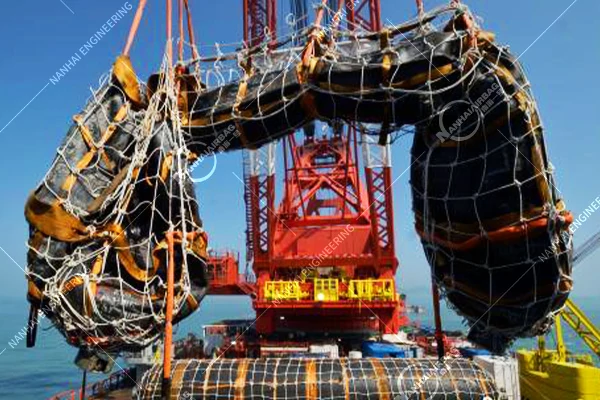Характеристики пневматических крыльев в экстремально холодных условиях
07/07/2025Стоит ли вкладывать деньги в сотовые крылья?
07/08/2025Как поднять затонувшее судно с помощью воздушных подушек для морских спасателей
Как NANHAI поднимает затонувшие суда с помощью спасательных подушек безопасности
Подъем затонувшего судна требует тщательного планирования и исполнения. Компания NANHAI специализируется на морских спасение Мы проводим операции, и один из наших наиболее эффективных методов - использование морских запасные подушки безопасности. Эти надувные блоки плавучеститакже известный как понтон подушки безопасности или сверхмощный грузовые мешкиОбеспечивают значительную грузоподъемность и гибкость для различных спасение сценарии. Наши прочные спасательные камеры разработаны в полном соответствии с требованиями ISO 14409 стандарты, обеспечивающие надежность в сложных подводных условиях.

Вот подробное, пошаговое руководство о том, как компания NANHAI поднимает затонувшие суда с помощью морских запасные подушки безопасности:
Шаг 1: Оценка и планирование перед спасением
Прежде чем приступить к физической работе, необходимо провести тщательную оценку для успешного спасательная операция.
- Осмотр местности и оценка ущерба: Сначала наша команда проводит комплексное обследование затонувшего судна и окружающей его среды. Это включает в себя:
- Определение точного местоположения, глубины и ориентации судна на морском дне.
- Оценка степени повреждения корпуса и надстроек.
- Анализ состояния морского дна (например, ил, песок, камень) и потенциальных препятствий.
- Оценка приливов и отливов, течений и прогнозов погоды на период спасение.
- Разработка плана спасения: На основе проведенной оценки инженеры NANHAI разрабатывают подробный спасение план. В этом плане указаны:
- Тип, размер и количество морских судов запасные подушки безопасности требуется. Мы выбираем подходящий грузовые мешки в зависимости от веса и конфигурации судна.
- Оптимальное размещение подушки безопасности это достижение стабильного и контролируемого подъема.
- Расчет плавучести, необходимой для преодоления веса судна под водой и любого дополнительного сопротивления (например, всасывания с морского дна). Наш сайт надувные блоки плавучести разработаны для обеспечения точного подъема.
- Выбор соответствующего подъемного оборудования (например, лебедок, кранов), если это необходимо, в сочетании с подушки безопасности.
- Протоколы безопасности и аварийные процедуры для спасение усилия.
- Экологические соображения и меры по предотвращению загрязнения окружающей среды во время спасение.
Шаг 2: Подготовка площадки и работа водолазов
После того как план окончательно утвержден, наши команды подводников готовят судно и место для погружения. спасение.
- Создание рабочей платформы: При необходимости используйте рабочую платформу или спасение Баржа размещается рядом с затонувшим судном, чтобы служить базой для проведения операций, хранения оборудования и поддержки водолазов.
- Расчистка завалов: Водолазы убирают любой мусор вокруг или на судне, который может помешать подушка безопасности размещение или зацепление во время подъема.
- Пункты досмотра и охраны судов: Водолазы проводят тщательный осмотр корпуса судна, чтобы определить подходящие места для крепления запасные подушки безопасности. Эти точки должны быть конструктивно прочными, чтобы выдержать огромную подъемную силу, создаваемую подушки безопасности. При необходимости можно добавить усиление.
- Такелаж и крепление: Наши дайверы тщательно оснащают морские запасные подушки безопасности к обозначенным точкам крепления на судне. Это включает в себя:
- Пропускайте прочные ремни или цепи через встроенные D-кольца или стропы на подушки безопасности.
- Крепление ремней или цепей к прочным точкам на судне, таким как кнехты, клинья или специально подготовленные падеи. Способ крепления имеет решающее значение для обеспечения надувные блоки плавучести надежно удерживаются на месте во время надувания и подъема.
Шаг 3: Надувание подушки безопасности и контролируемый подъем
Это основной этап спасательная операциятребующий точного контроля над подушки безопасности.
- Подключение подачи воздуха: Воздушные шланги от компрессоров высокого давления на поверхности (либо на спасение судно или берег) соединены с надувными клапанами морского запасные подушки безопасности.
- Контролируемая инфляция: Воздух медленно и постепенно вводится в подушки безопасности. Этот процесс тщательно контролируется компанией NANHAI спасение мастера, которые в режиме реального времени получают данные с манометров и датчиков глубины.
- Равномерное распределение плавучести: Надувание обычно происходит поэтапно, часто надувая несколько грузовые мешки одновременно, чтобы обеспечить равномерное распределение плавучести и предотвратить неконтролируемый крен или опрокидывание судна.
- Мониторинг и корректировка: Водолазы постоянно контролируют подушки безопасности' производительность и движение судна, внося необходимые коррективы. Это часто включает в себя точную настройку давления воздуха в отдельных запасные подушки безопасности для поддержания устойчивости и контроля скорости подъема судна.
- Постепенное восхождение: Как надувные блоки плавучести Наполняясь воздухом, они вытесняют воду, создавая восходящую силу. Судно постепенно приобретает плавучесть и начинает подниматься над морским дном. Скорость подъема контролируется для предотвращения резких движений, которые могут привести к дальнейшему повреждению судна или оборудования в этот критический момент. спасение фаза.
- Балластировка поверхности (при необходимости): Как только судно приблизится к поверхности, NANHAI может частично снять балласт с внутренних танков затонувшего судна, чтобы обеспечить устойчивость и контроль за окончательным всплытием, при поддержке запасные подушки безопасности.
Шаг 4: Буксировка и эвакуация
После того как судно успешно поднято на поверхность, наступают последние шаги по его закреплению и восстановлению.
- Стабилизация: После выхода на поверхность судно стабилизируют, часто регулируя количество воздуха в подушки безопасности или выкачиванием оставшейся воды из доступных отсеков.
- Буксировка: Всплывшее судно, часто все еще поддерживаемое запасные подушки безопасностиЗатем его осторожно отбуксируют в безопасную гавань, сухой док или специально отведенное ремонтное предприятие. Сайт надувные блоки плавучести могут оставаться прикрепленными для обеспечения плавучести и устойчивости во время транспортировки.
- Дефляция и удаление: После того как судно закреплено в пункте назначения, морские запасные подушки безопасности сдуваются и аккуратно снимаются, чистятся, осматриваются и подготавливаются к дальнейшей эксплуатации. спасение использовать.
Опыт NANHAI в использовании морских запасные подушки безопасности позволяет нам вести эффективную, безопасную и экологически ответственную деятельность. спасательные работыЭто позволит свести к минимуму дальнейший ущерб затонувшему судну и обеспечить его успешное восстановление. Наш сайт подушки безопасности являются жизненно важным инструментом в сложных подводных спасение проекты.
